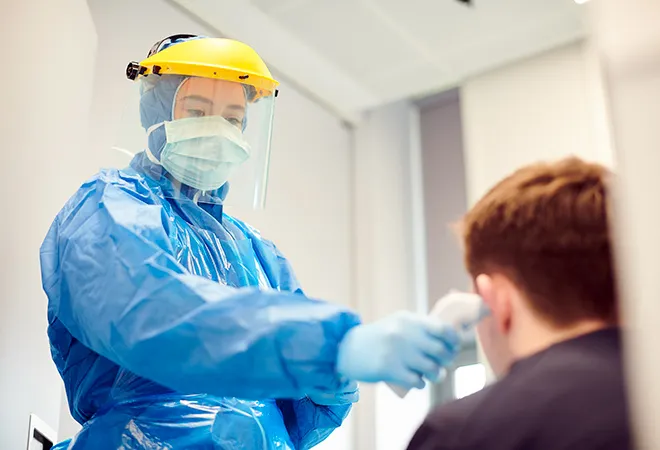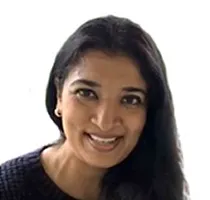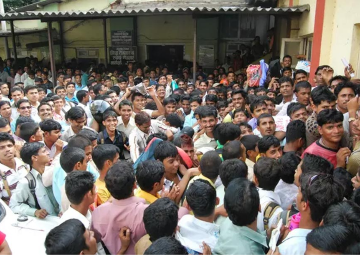
As the US coronavirus case load nears the 200,000 mark, the death toll inches towards the 4,000 and America braces for a worst case scenario of 200,000 deaths, doctors, nurses, frontline healthcare workers and caregivers are bubbling into our screens not merely in their work avatars but as surrogates for the anxious commoner, co-creators of medical gear and storytellers working on the cliff-edge of a pandemic.
Shaken by their own high-risk exposure to the virus, the lack of personal protective gear and incredible physical strain, this community has brought on the latest breed of digital radicals talking to us from where cameras cannot go and where people are saying their final goodbyes in utter isolation. Doctors and nurses are showing us a mirror to our interconnected vulnerabilities; they have shattered the illusion that the US was ready for this outbreak. Medical lingo is having its breakout moment. When was the last time words like ‘comorbidities’, ‘immunocompromised’, ‘viral load factor’, ‘attack rate’, and ‘underlying conditions’ were the stuff of red hot social threads for days on end? The medical is now everyone’s personal, caregivers are the rock stars of the emerging Covid 19 culture and mighty governments are bowing to their collective wisdom.
Here are three takeaways from an edgy new style of real-time public education in the annals of America’s new social order:
1. How two doctors forced a Trump U-turn
Let’s start right at the top and then go downstream. Here’s how US president Donald Trump, who talked up opening the US economy before Easter weekend, did a 180 degree turn within hours. The abrupt shift came after two of America’s most renowned doctors - Dr. Anthony Fauci and Dr. Deborah Birx — spearheading the White House Covid 19 task force — spread out their charts on Trump’s desk. “Dr. Debbie Birx and I went into the Oval Office and leaned over the desk and said, ‘Here are the data, take a look.’ He just shook his head and said, ‘I guess we got to do it’”, Fauci explains. The charts that Fauci refers to are predictive models showing millions of deaths if there was zero mitigation in place. Off the two doctors, Birx has found ways to warn Americans about the virus in deeply personal terms.
As Americans grappled with Phase One of social distancing norms, Birx dusted out the story of her grandmother Leah who “lived with a lifetime of guilt” because she caught the flu at school and brought it home to her mother who had just given birth. Leah’s mother died of the flu — one of an estimated 50 million worldwide who died in the 1918 influenza epidemic. “I can tell you, my grandmother lived with that for 88 years,” Birx said, and added: “This is not a theoretic. This is a reality.” Fauci, America’s top infectious diseases doctor, has become a national star for his “data-led” storytelling. Raspy voiced, Fauci, who has advised every president since Ronald Reagan, is now the subject of fan art, donuts and socks which are selling out as he rocks Instagram and YouTube and linear TV all at once. Fauci’s 30-minute Instagram conversation with basketball star Stephen Curry has become a yardstick for jargon-free public education. The image of the wealthy, infected celebrity is no longer the barometer for this transformational moment. In the altered universe, that frame belongs to stoic, sleepless, “mathy” kind of people in scrubs.
2. Delivering on the original promise of social platforms
For all the flak that social media platforms got after the 2016 US elections, the Covid 19 pandemic is showing that Twitter, Facebook, YouTube and others are journeying back to their original promise of helping communities organise. Out there in the hospitals, caregivers and frontline staff have become our go-to sources for media reportage from the trenches, when they’re not intubating patients or triaging.
Responsible voices are breaking through and helping the world shorten turnaround times on understanding a crisis in real time. Urgency oozes from a Stanford doctor’s tweet asking for best practices for "last resort" homemade masks. “Sewing patterns? Evidence? Filter pocket? Materials?” she writes. Stumbling out of red eye shifts, medical residents are penning hurried notes to the world. “Last night in the ICU of a #NYC hospital, I cared for 20 patients who were all on breathing machines due to #COVID19. Some really young (20s), without comorbidities. Everyone is extremely sick. But sicker patients keep flooding in.” While Fauci and Birx got the charts ready, doctors outside the White House kept up the pressure. Reacting with alarm to Trump’s comments, America’s best and brightest medical professionals pushed back on the US president’s favorite platform. “If you don’t solve the medical crisis, you will not solve the economic crisis. #Buyustime”, Pulitzer Prize winning oncologist-writer Dr. Siddhartha Mukherjee tweeted. “The 15 day quarantine plan is a disaster”, he said. Wherever state governments are keeping a safe distance from taking tough calls, doctors are wading in fearlessly. Should we all be wearing masks? While governments told us masks are not needed, practicing physicians debunked it and began requiring everyone in their hospitals to wear it, not just the first line staff. A grassroots pro-mask movement supercharged by social media educational content has already changed how people are covering their faces in America’s neighborhoods.
Before this, it was school closures. There too, the “government does not recommend it” was the operative recommendation. The community took over, driven to action by the last doctor or nurse’s post they saw on their phones. That distance between doctors and the masses has rarely been smaller than it is now.
3. In doctors’ questions, we find our answers
Doctors turned storytellers have taken their sophisticated writing to the masses and we are all better for it. The questions they are asking tell us how much we don’t know, and we, in turn, are filling those gaps with obsessive hand washing, mask wearing and disinfecting — actions that makes us all safer. Can we quantify the increase in risk for higher exposure to the Covid 19? What about the severity of the initial exposure? How much of a role does the first hit play in how ill the patient becomes? Is there data on how the virus moves through the body? How much of the Singapore - Hong Kong policy is essential to flatten the curve elsewhere? Even as we absorb the meaning of these unknowns and evaluate our options for the micro- moments of our lives, our social media feeds turn surreal again. Take David Lat, who describes himself as an athletic 44 year old, “asleep in a normal hospital room, and the next thing I knew, I was in a scene out of "ER" — being shot up with drugs and having a tube shoved down my throat”. Elsewhere, a woman from Nevada sends us a “gentle reminder to hold your loved ones tight tonight if you can” and then 10 hours later, tells of her grandmother’s passing, from Covid 19. As we turn inwards and find new rituals in closed spaces, our fingers, more shriveled each day from excessive hand washing, stumble into new storytellers.
The views expressed above belong to the author(s). ORF research and analyses now available on Telegram! Click here to access our curated content — blogs, longforms and interviews.




 PREV
PREV


